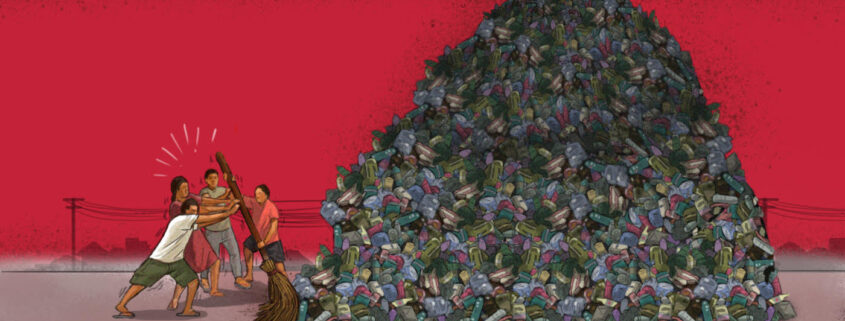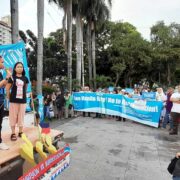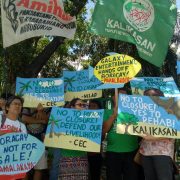Philippine towns, cities are paying high cost of waste management. Plastic producers should help
Quezon City is paying an average of P1.6 billion annually for solid waste management. An imperfect new law mandating plastic producing companies to collect their materials – if strictly implemented – could reduce waste in landfills and provide financial respite to LGUs.
By ELYSSA LOPEZ / Philippine Center for Investigative Journalism (PCIJ)
Last of two parts
Tucked in the corner of the Dultra family’s garage are sacks full of used plastic packaging. There are water bottles, and bubble wraps—remnants of the family’s daily living consumption.
“Our family has made a practice of keeping our plastic waste in one bag,” said Sarah Dultra, the family’s matriarch. “So when the barangay official comes we can easily hand it in.”
In her barangay, located in the province of Rizal, east of Manila, officials visit households twice a month to retrieve segregated plastic wastes. Each household earns an entry into the barangay’s year-end Christmas raffle, where winners may bring home small appliances or a sack of rice.
The barangay has also set up a materials recovery facility (MRF), equipped with a machine that can shred plastics into tiny pieces that can be molded into an eco-brick. Each piece can be sold for P26.
The whole practice has been so successful that it has helped the barangay employ four more employees, and add more revenues into their coffers. It’s all part of the barangay’s solid waste management program, and in theory, what the Ecological Solid Waste Management Act of 2000 envisioned each barangay would be.
But as of 2022, the Dultra family’s barangay was a mere outlier.
More than two decades after its passage, local government units’ (LGUs) compliance has been found wanting. There are only 318 sanitary landfills (SLFs) nationwide for the 1,715 LGUs in the country, and 16,418 MRFs for 42,036 barangays.
“Our waste problem is such because we lack the proper infrastructure needed to process them,” said Dr. Tonette Tanchuling, director of the University of the Philippines Institute of Civil Engineering.
Financial respite for LGUs
A ban on single use plastic would have had an immediate result. The country’s “sachet economy” has often been cited as one of the reasons for the country’s waste problem.
Aside from convenience, sacheted products are the cheapest and most accessible products for many Filipinos. But because the materials used in the production of such are unrecyclable, they often clog landfills, or worse, leak to the environment.
The EPR law, while it’s not the ideal solution for environmentalists, should reduce the plastic wastes that end up in landfills and offer financial respite to LGUs.
A PCIJ analysis showed that from 2017 to 2020, LGUs in the National Capital Region (NCR) alone spent an average of P384 million over the four-year period on waste management. The analysis is based on the financial statements of the NCR’s 16 cities and one municipality, which include expenditure for “environment and sanitary services.” The item includes an LGU’s expenses on garbage collection and disposal and other sanitation programs.
The huge amounts spent by LGUs on waste management are still far from the ideal, said Miko Aliño of Break Free From Plastic.
“If a particular city tries to upgrade its waste management infrastructure, it would cost as much as 20 percent of its annual budget. That’s how much waste management [should] cost, in an ideal world,” he said.
Based on PCIJ’s analysis, current spending on waste management of LGUs in NCR is less than a tenth of their annual budgets.
Sen. Cynthia Villar’s original bill in the Senate would have been more favorable to LGUs. SB 1331, before she filed substitute bill SB 2425, called for corporations to coordinate with municipal and city waste management offices so that the LGUs may benefit from direct incentives. This was removed in her substitute bill. Instead she listed “possible” EPR programs that obliged enterprises may adopt. This language was eventually maintained in the final version of the law. (TIMELINE: EPR in the Philippines: Law pushed by plastic producers took 15 months to hurdle Congress)
PH’s EPR law is ‘polluter friendly’
The EPR law could still provide aid to LGUs if it’s implemented strictly.
Under the EPR law, a company must recover 20% of its plastic wastes by year-end of 2023, a target that increases by 20% a year until it reaches 80% by the end of 2028. The company is required to register its EPR program with the Department of Environment and Natural Resources (DENR) for proper audit. It may undertake its own EPR program or tap another party called the producer responsibility organization (PRO), such as PBSP and PARMS, to do this.
These obliged enterprises and PROs are free to choose however they wish to “recover” the waste they produce, as long as these activities are the ones cited under the IRR of the EPR law. For instance, it encourages enterprises to redesign their products for better recyclability, and to establish recycling facilities themselves.
But for civil society groups, the EPR Act of the Philippines is “polluter friendly” because it only provides plastic waste recovery targets for manufacturers, and not a clear timeline for phaseouts of plastic products.
Case in point: Plastic Credit Exchange (PCX), one of the more popular organizations that have registered as PRO, employs a “waste diversion” scheme that had long been frowned upon by environmentalists: co-processing.
The organization, like PARMS, connects companies with waste recovery firms for a fee. The company’s website says it has helped Unilever recover plastic waste for $350 per ton. It collects plastic wastes that could, later on, be fed as feedstock in cement kilns. This process requires incineration, which is technically illegal under the Clean Air Act. But administrative orders issued by the DENR over the years have allowed such facilities to keep operating.
A PCIJ report earlier revealed that government monitoring of such facilities is not at par with the country’s Asian neighbors. The emission standards for these sites have also not been updated ever since the Clean Air Act was passed in 2001.
“It [the policy] encourages unsustainable and false solutions to the waste crisis such as chemical recycling, cement kilns, and waste-to-energy incinerators. Recycling alone will not solve the waste and climate crisis,” Kabataan Partylist Rep. Sarah Elago said when she voted against the bill.
EPR was intended to create a market for waste processing facilities and contribute to the establishment of a circular economy, where companies are incentivized to adopt a “holistic eco-design’’ of their products, according to the World Wide Fund.
The policy of circular economy, introduced in the 1980s, “aims to make producers responsible for the environmental impacts of their products throughout the product chain, from design to the post-consumer phase.”
Since then it has been widely adopted by affluent countries, such as Japan, South Korea, and the European Union state-members. At least 400 EPR schemes are used worldwide, according to the Organisation for Economic Co-operation and Development (OECD).
It’s a welcome development since it comes at a time when governments worldwide are committing to lowering greenhouse gas emissions to slow down global warming. The main component of plastic is fossil fuel, the main culprit for the planet’s rising temperatures over the last few years. At least 75 percent of the world’s greenhouse gas emissions are due to fossil fuels.
The Philippines’ EPR needs time to be effective?
Crispin Lao, executive director of PARMS (Philippine Alliance for Recycling and Materials Sustainability), said the industry needs time to show results. He has maintained that the industry is supportive of the EPR law despite its complaints about the gaps in the government’s information dissemination.
After all, for Lao, the law provides a “certain level of flexibility” that allows companies to comply. For instance, the law allows enterprises to lead clean-ups in coastal areas and public roads and register collected plastics in these activities as part of their EPR program. It also encourages them to put up water refillable stations to reduce plastic production in their supply chain.
But these activities are what environmentalists have frowned upon as it could lead to “false solutions” to the waste problem. “If you look at the framework of the EPR, it tackles plastic pollution but sees it as a litter problem, not as a production problem,” said Aliño of Break Free From Plastic.
This could then lead companies to focus on collecting and recovering wastes, instead of crafting a plan that would lead them to reduce plastic in their supply chain altogether.
“We have to be really cautious to stay true to the principles of EPR of making polluters pay. If we don’t take strong measures, it would be business as usual,” said Salamat of EcoWaste Coalition. END







